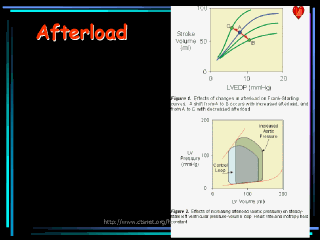| front |1 |2 |3 |4 |5 |6 |7 |8 |9 |10 |11 |12 |13 |14 |15 |16 |17 |18 |19 |20 |21 |22 |23 |24 |review |
 |
Afterload can be viewed as the
"load" that the heart must eject blood against. In simple terms, the afterload
is closely related to the aortic pressure. More precisely, afterload can be stated in
terms of ventricular wall stress (s ), where s µ (P r) / x (P - ventricular pressure; r - ventricular
radius; x - wall thickness). The pressure that the ventricle generates during systolic ejection is very close to aortic pressure, unless aortic stenosis is present. For a given pressure, wall stress is increased by an increase in radius (ventricular dilation), which will constitute an increase in afterload. A hypertrophied ventricle (thickened wall) will tend to reduce wall stress and afterload Afterload is increased when aortic pressure and systemic vascular resistance are increased, by aortic valve stenosis, and by ventricular dilation. When afterload increases, there is an increase in end-systolic volume and a decrease in stroke volume. As shown in Figure 1, an increase in afterload shifts the Frank-Starling curve down and to the right. The basis for this is found in the force-velocity relationship for cardiac myocytes. Briefly, an increase in afterload decreases the velocity of fiber shortening. Because the period of time available for ejection is finite (~150-200 msec), a decrease in fiber shortening velocity reduces the rate of volume ejection so that more blood is left within the ventricle at the end of systole (increase end-systolic volume). Inotropy is not directly altered, except for the possibility of a mild Anrep effect. Afterload per se does not alter preload; however, preload changes secondarily to changes in afterload. As shown in the Figure 1, increasing afterload not only reduces stroke volume, but it also increases left ventricular end-diastolic pressure (LVEDP) (i.e., increases preload). This occurs because the increase in end-systolic volume is added to the venous return into the ventricle that results in an increase in end-diastolic volume. This increase in preload will stimulate the Frank-Starling mechanism to partially compensate for the reduction in stroke volume caused by the increase in afterload. This interaction between afterload and preload is utilized in the treatment of heart failure where vasodilator drugs are used to augment stroke volume by decreasing afterload, and at the same time, reduce ventricular preload. The effects of afterload on ventricular end-systolic and end-diastolic volumes are best demonstrated using pressure-volume loops (Figure 2). If afterload is increased by increasing aortic diastolic pressure, the ventricle will have to generate increased pressure before the aortic valve opens. The ejection velocity after the valve opens will be reduced because increased afterload decreases the velocity of cardiac fibers shortening as described by the force-velocity relationship. Because there is only a finite time period for electrical and mechanical systole, less blood will be ejected (decreased stroke volume) so that there is an increase in ventricular end-systolic volume as shown in the pressure-volume loop. Because end-systolic volume is increased, this extra blood within the ventricle will be added to the venous return thereby increasing end-diastolic volume. Ordinarily, in the final steady-state (after several beats), the increase in end-systolic volume will be greater than the increase in end-diastolic volume so that the difference between the two, the stroke volume, is decreased (i.e., the width of the pressure-volume loop is decreased). |
| front |1 |2 |3 |4 |5 |6 |7 |8 |9 |10 |11 |12 |13 |14 |15 |16 |17 |18 |19 |20 |21 |22 |23 |24 |review |